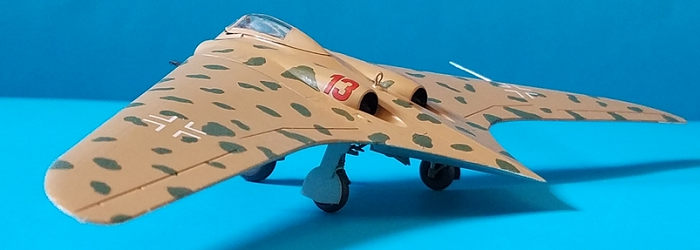
Revell 1/72 Horton Ho.229
| KIT #: | 4312 |
| PRICE: | $34.00 |
| DECALS: | Two options |
| REVIEWER: | Francisco Santoro |
| NOTES: | Warped wings at the tips, fiddly nose gear construction. |

| HISTORY |
It was a hot day at the base of JG 27's 3rd Group in Mersa Matruh. After the British defeat at Malta with the help of the Italians in 1943, the Axis had been able to provide a secure channel through which to supply Rommel's Afrika Korps. The year was now 1948, and the Axis was on the verge of invading Egypt. Heinz Bär, the world's first jet fighter ace, was taking a stroll around the 3 Group's airfield when he stopped to look at the unit's 12 brand new Horten Go 229s, "I can't believe I flew Bf 109Es 18 years ago." Bär approached to the aircraft and took a closer look to it, he was still amazed how far jet design had come since the He 280s first flight. Moments later, he went back to the control room to brief the pilot's about the day's mission. "We've been ordered to make a combat patrol near the Egyptian border to clean the skies of enemy aircraft, in order to give free way for the bombers of KG 7 "Afrika," Bär said. "We're taking off immediately."
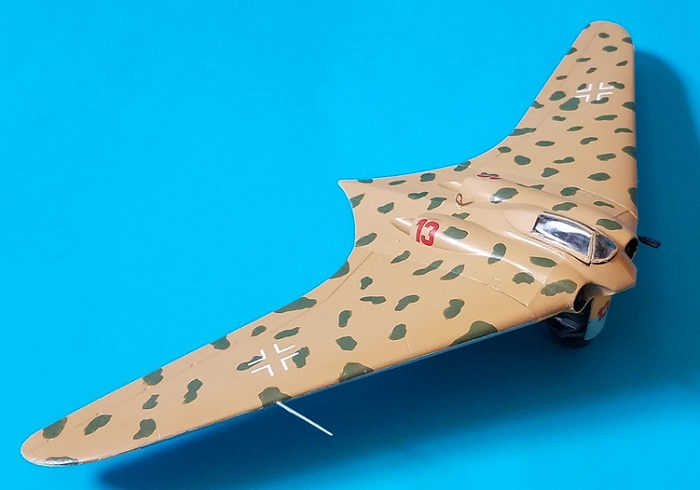 He selected 8 pilots and walked with them to the aircraft, the ground
personnel already had connected the generators to the aircraft for a
quick start. Bär climbed onto his aircraft, marked Red 13, and started
his engines. The other 7 pilots followed. After being cleared by the
tower, they taxiied and took off one by one, levelling at 30000ft.
He selected 8 pilots and walked with them to the aircraft, the ground
personnel already had connected the generators to the aircraft for a
quick start. Bär climbed onto his aircraft, marked Red 13, and started
his engines. The other 7 pilots followed. After being cleared by the
tower, they taxiied and took off one by one, levelling at 30000ft.
After 30 minutes of flight, the 8 aircraft were near the Egyptian border. "Captain, 6 enemy aircraft 2000ft below us, they appear to be Meteors!," one of the pilots said. "Roger, said Bär. Everyone, line up for an attack." The German pilots had an altitude and position advantage since they had the sun behind them. One by one, the German pilots descended over the British aircraft, Bãr shooting down the leader of the flight, reaching 250 kills. The British aircraft immediately dispersed, surprised with the sudden attack. Each pilot had a go at the British aircraft, and when the former tried to get behind the Hortens, the latter simply broke off combat due to the superior performance of their aircraft. In the 20 minutes of combat, the German pilots shot down 4 British aircraft, while the others went back to their base. "Great work," said Bär, "return to base for a deserved rest." Just as they were nearing Mersa Matruh, the 8 pilots cought a glimpse of the 4 Ar 555s of I/KG 7 flying to Alexandria.
The reality (from the kit instructions): "Until the end of the Second World War the Horten brothes Reimar and Walter were, apart from Alexander Lippisch, the most well known designers of flying wing aircraft in Germany. In 1933 they built their first un-powered flying wing, the H-I, and in 1934 the H-II motorised glider. 1937 saw the development of the first flying wing constructed of plastic. This aircraft was however destroyed on its first landing. The plastic used on its construction was found to be too brittle.
The Horten designs were otherwise not very different to each other. The mid section containing the cockpit was of tubular construction with an appropriate covering and mounting points left and right for the fabric covered wings. Both single and twin engines with pusher propellers and the nose wheel were mounted within this framework.
The H-II was presented to members of the RLM as early as 1934. Ernst Udet was, as Chief of the Technical Office of the RLM, won over to the flying wing lobby.
The development of engined powered flying wing aircraft was continued
from 1937 onwards with the support of the RLM. After the start of the
war, the brothers were able to continue development within the framework
of a special command of the Luftwaffe. The twin engine prototypes H-V
and H-VII V1 proved th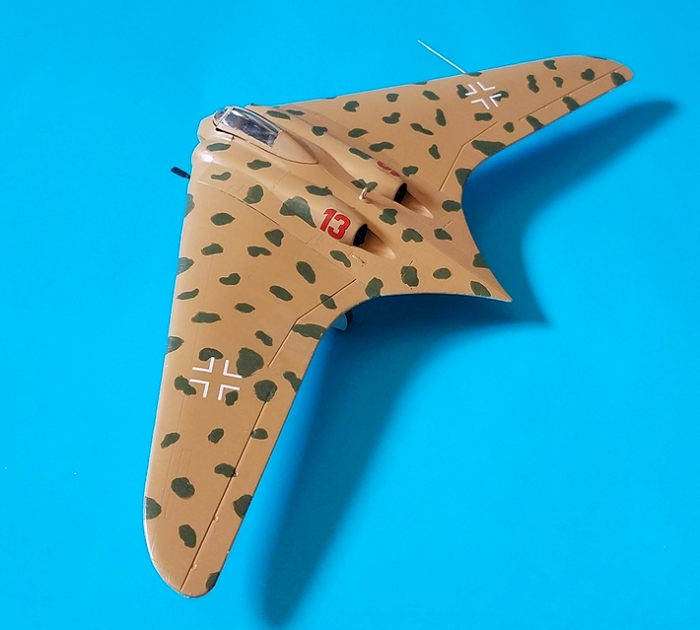 emselves to be successful designs. Reichmarschall
Hermann Göering showed so much interest that allowed the H-VII to be
demonstrated to him in Oranienburg in 1944.
emselves to be successful designs. Reichmarschall
Hermann Göering showed so much interest that allowed the H-VII to be
demonstrated to him in Oranienburg in 1944.
Preparation of the turbine powered flying wing H-IX began in 1943 in Göttingen. As well as the proven wood and tubular steel construction and the trycicle undercarriage, two BMW 003 engines were envisaged. Apart from the area of the engines, the aircraft was to be completely planked in plywood. With this project, Hermann Göring was promised an aircraft that could carry a 2000kg (4400lbs) weapon load over 700km (400 miles) at a speed of 900km/h (500 mph).
Work on an unpowered prototype began shortly after. The successful maiden flight of the prototype H-IX V1 took place on February 28 1944. A brake parachute was installed in the tail in order to reduce the requiered landing distance. Further development towards the first turbine powered flying wing aircraft in the world was, however, delayed for months by the Aviation Ministry. Instead of the BMW 003 turbines, the V2 needed to have the larger Jumo 004 engines installed. For this reason, the aircraft had to be redesigned.
The unarmed trial version was completed in Göttingen at the start of 1945. The maiden flight took place on February 2, 1945 in Oranienburg. The aircraft landed 30 minutes later in the hands of the experienced test pilot Lieutenant Erwin Ziller. On the following day, the aircraft sustained damage during landing. The third flight ended after 45 minutes on February 18, 1945 with the total loss of the aircraft. The pilot lost control of the aircraft during the approach to land, and the V2 broke up on the ground short of the airfield. Erwin Ziller lost his life, and the reasons for the crash were never found.
The Gothaer Waggonfabrik (GWF) had already received an order for the series production of the single seat fighter Go 229 at the end of 1944. The Gothaer engineer´s plans envisaged an armament of two MK 103s for the V6. After the loss of the V2 it was decided to continue further tests with the first three Gotha GWF aircraft without additional equipment and armament. The building of these protytpes was halted due to the end of the war in 1945. The completion of the centre section and wings of the V3 continued later under the auspices of the Americans. The aircraft was later taken to the United States of America as part of the war reparations."
| THE KIT |
 This is one of Revell´s many Luft 46 kits. It was first issued as the Horten
IX/Go 229 in 1994, together with the Ar 555 and BV 194, when the hype for
the "what if" Lufwaffe paper projects was at its peak.
This is one of Revell´s many Luft 46 kits. It was first issued as the Horten
IX/Go 229 in 1994, together with the Ar 555 and BV 194, when the hype for
the "what if" Lufwaffe paper projects was at its peak.
The kit comes in Revell´s blue side opening box. Inside, there´s a single bag containing three light grey sprues and the clear parts. The parts are flash free, and have finely done recessed panel lines, with raised rivets near the engine intakes and near the main landing gear wheel wells.
The instruction sheet consists of the typical Revell format, printed in newspaper quality, with a brief history of the aircraft, warnings in several languages, and 25 building steps in black and white.
Decals were printed in Italy, and have two (ficticious) options:
1) Ho 229 "Red 13," JG 400, painted in RLM 74/75/76/04.
2) Ho 229 "Blue 4," JG 400, painted in RLM 81/82/76/04.
| CONSTRUCTION |
I began by painting the cockpit parts, framing and interior of the fuselage
with Revell 78 (RLM 66). The instrument panel was painted with flat black. I
also painted the landing gear parts with Revell 45 (RLM 02) and wheels in
flat black and tyre black, so as to speed up final construction after
decalling the kit. After the parts were dry, I applied the instrument panel
decal onto the instrument panel, since t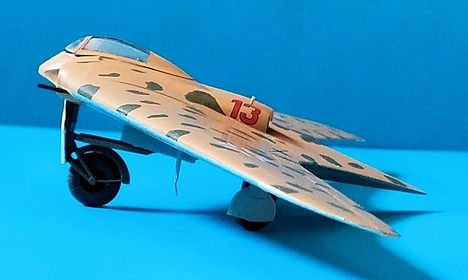 hat part is flat. I next glued the
nose wheel well into the upper fuselage half, together with the pilot´s
seat, forgetting to also glue the cockpit framing. Luckily, the space left
to the left and right of the seat was enough for me to fit the framing
without too much of a fight. At this stage, also glued the instrument panel,
which must go in front of the two little pegs on the cockpit framing. When
the instrument panel was dry, I glued above it another part of the cockpit
framing.
hat part is flat. I next glued the
nose wheel well into the upper fuselage half, together with the pilot´s
seat, forgetting to also glue the cockpit framing. Luckily, the space left
to the left and right of the seat was enough for me to fit the framing
without too much of a fight. At this stage, also glued the instrument panel,
which must go in front of the two little pegs on the cockpit framing. When
the instrument panel was dry, I glued above it another part of the cockpit
framing.
I left the cockpit alone and concentrated on the lower half of the fuselage. I glued its framing into place, and while it dried, I built the small sub-assemblies, such as the engine inlets, engine nozzles, and the MK 103 cannons. All those piecess were then glued to their respective places (inlets into the nose of the plane, nozzles to the upper fuselage half, and the guns to the lower fuselage half).
Next step involved getting the wings together. These are a matter of lower and upper pieces. I glued them together, and when dry, were glued to the aircraft´s fuselage.
| COLORS & MARKINGS |
Since Heinz Bär flew with the number 13 in his planes while he was in the
Luftwaffe, I decided I´d use the first option of the kit decals. I cleaned
the entire model with alcohol, so the surface would be free from any grease
from my fingers. I then painted the entire upper surfaces with Revell 17
(RLM 79), left to dry, and then painted the mottling with Revell 361 Olive
Green (RLM 80). This colour looks much better than the RLM 7 0 I used on my Ar 555, but it puddled too much on the surface, even though I tried thinning
it out with water. With the upper surfaces done, I painted the undersides
with Revell 49 (RLM 65). The wingtips were painted in white, representing
the Mediterranean and North African front identification markings. The nose
of the aircraft was then painted in yellow. The model was then prepared for
the decals by brushing Revell´s clear varnish all over it.
0 I used on my Ar 555, but it puddled too much on the surface, even though I tried thinning
it out with water. With the upper surfaces done, I painted the undersides
with Revell 49 (RLM 65). The wingtips were painted in white, representing
the Mediterranean and North African front identification markings. The nose
of the aircraft was then painted in yellow. The model was then prepared for
the decals by brushing Revell´s clear varnish all over it.
This is the second time I see Revell decals acting strangely (first on my Mustang III from Tamiya, where the Revell decals I used didn´t conform to the lower wing). This time, they were sticky, a first for me with Revell, so after I applied the first Iron Cross, I brushed the surface of the aircraft with water, and slid the decals into place, using a cotton bud to remove the remaining water. I deviated slightly from the instructions by using the Iron Crosses with the white filling instead of using the ones with the black outlines. The model was then matt varnished with Revell´s matt varnish.
| FINAL CONSTRUCTION |
This part consisted on gluing the landing gears, their doors, DF loop and whip antenna, the pitot tube, and masking and attaching the canopy.
The front landing gear is a quite fiddly assembly, consisting on the nose
wheel strut and the four pieces that make the retraction arms. I first glued
the nose gear in place, and then added the retraction struts. The last piece
of the nose gear is an x-shaped strut, which goes between piece 34 (the
retraction fork) and a small recessed area on the framing of the lower
fuselage half. This piece was a nightmare to glue, because
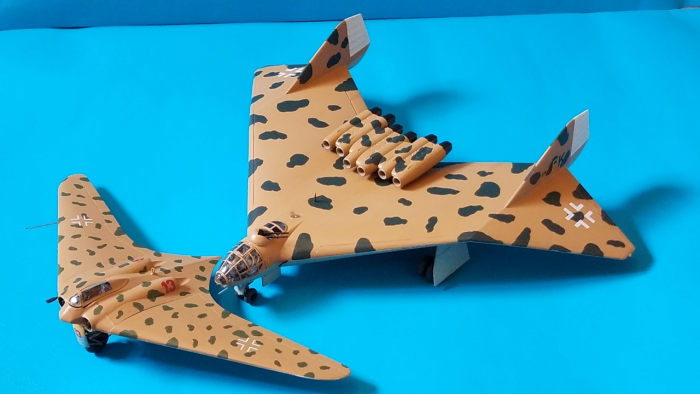 it either kept
falling into the big opening that is the nose gear wheel well, or it didn´t
reach the contact area. I was able to finally get that piece into place and
move on to the main gear. The main landing gear is a straight forward
affair: I attached one strut first, and then the retraction strut. I
repeated the same thing for the other side, while taking care both were
correctly aligned with each other. I attached the landing gear doors as soon
as the landing gear was dry.
it either kept
falling into the big opening that is the nose gear wheel well, or it didn´t
reach the contact area. I was able to finally get that piece into place and
move on to the main gear. The main landing gear is a straight forward
affair: I attached one strut first, and then the retraction strut. I
repeated the same thing for the other side, while taking care both were
correctly aligned with each other. I attached the landing gear doors as soon
as the landing gear was dry.
With the aicraft on its wheels, I attached the whip antenna, the DF look antenna, and the pitot tube.
I finally masked and painted the canopy, first with the fuselage interior colour, and then with RLM 79. I tried to glue the windscreen first, but the contact surface was too small for the glue to have a grip, so I glued the windscreen to the canopy, and then glued the whole canopy to the fuselage. This left me with a gap, because the canopy doesn´t follow the curvature of the cockpit opening (vacuform cockpit would be recommended for the more serious modeller).
| CONCLUSIONS |
Another fine Luft 46 kit done by Revell. Except for the main nose landing gear, the aircraft was a pleasure to build and looks really good together with my Ar 555. Zoukei Mura announced a new 1:72 Ho 229, whether it´ll replace the Revell offer when it´s released, is something to be seen.
| REFERENCES |
Kit instructions.
Francisco Santoro
16 June 2020 Copyright ModelingMadness.com.
If you would like your product reviewed fairly and fairly quickly, please contact the editor or see other details in the Note to Contributors.
Back to the Main Page Back to the Review Index Page Back to the Previews Index Page